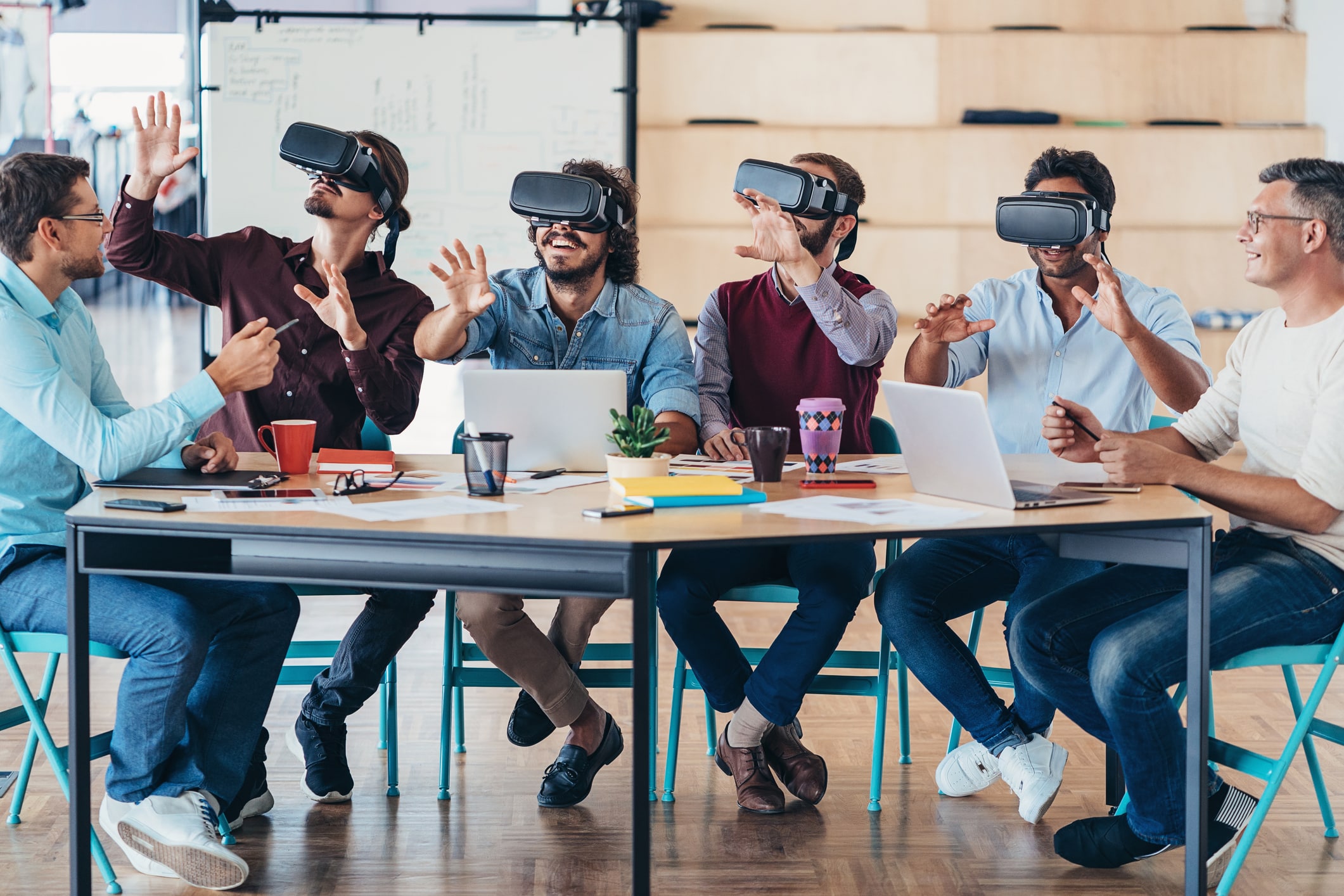Exploring the Benefits of VR for Collaborative Work
Florian Limburg
October 3, 2023

Since university, I’ve been very much interested in virtual reality. Since then, VR gear has been rather expensive and hard to come by. Nowadays, this is not the case. I was gifted with a Quest 1 by my wife and my investigation into VR began, mostly for entertainment. Work topics were only an afterthought, but one that kept sticking. Even though the resolution of the Quest 1 was not up to the task, I saw a lot of potential there. Currently, many people are looking into the benefits and problems of VR and its usage, especially for work. Most research does find more benefits than issues. After discussing the possibilities of VR in the workplace with Emma McGrattan, she took me up on it right away and got me a Quest 2. The ‘official’ trial I agreed upon with Emma was around two months, in which I noted down all my impressions and as many hard facts as I could find. During this time, I spent something around 4-6 hours a day using Immersed. Personally, I noticed an increase in compile time of up to 25% when compiling some large-scale C code.
So, how do you work in VR if you don’t work on VR topics? You must bring your work into your virtual environment. For this, there are two basic approaches:
- Make your normal computer a VR device using SIMULAVR.
- Bring your work computer into VR by means of some form of remote desktop, for this, there are already a lot of applications on the market. All with a slightly different approach:
- Bigscreen: Entertainment, watching movies/games together with others, having a house party. The stream resolution is not suited for text, but movies are awesome.
- Virtual Desktop: Playing games or watching movies by yourself. The screen quality is awesome. Text can be easily read. Great to play VR games using your VR Headset.
- Horizon Workrooms: Geared towards work, up to three useable screens in a single room or one single screen and a large wall display in a shared room. It is best suited to recreate the feel of a meeting room. Interesting for small presentations and workshops. Easy to use.
- Horizon Infinite Office: Working alone with web applications in low-resolution windows. It looks nice, but not suited for heavy lifting.
- vSpatial: Interesting approach to window management. Either observe multiple applications in a carousel or concentrate on one large screen. Use the cooperation feature by connecting a handful of people into one call.
- Immersed: Up to five completely freely positionable screens in private, shared, or public environments. Screens can be shared. Support for Linux, Windows, and MacOS. Very good text readability, and refresh rates high enough to watch a movie.
After trying out all the options I could find, weighing the various approaches and operating system support, Immersed was a rather clear winner. The main goal is to give the user freedom to arrange his working environment. For example, the screens should allow for deep-focus work and improved productivity, while also giving options to collaborate with people as if they were in the same room. Essentially, you run a remote desktop agent on your computer and connect to it via a network from your VR Headset.
Immersed offers various rooms with different themes and layouts. They can be public, as in every Immersed user can join them, they can also be solo, only you can join or you can invite up to four people to join. Alternatively, you surround yourself with a 360° panorama view. Personally, I spent the most time on a tropical island panorama found on Google Street View. If you are not into virtual environments or need to keep an eye on your kids or pets, there is passthrough mode in which your environment will be a live feed of the headset’s cameras. In the case of the Quest 2, it is a gritty greyscale video, while the Quest Pro is a 3D color video. In the solo rooms, it is surprisingly easy to focus on your work and increase your productivity. You won’t even need to leave VR for your video calls, as the application offers a virtual webcam, that will stream your virtual avatar from your chosen location to the call.
The Positive
- I really love working on multiple screens. I never liked using virtual desktops, that feature where you can switch between different applications and window layouts. I feel a lot more comfortable and flexible when I can distribute all the windows across 3 or more screens. It just feels more natural for me to turn my head than to use a shortcut to switch desktop views. Together with my limited real estate at home for my working area, the VR headset is a game changer. Together with some minor tweaking on the wireless setup, I can now sit at many different spots at home and still have more than just one tiny laptop screen.
- Focusing on your work is easier. When working in VR, I do feel more concentrated and productive.
- Co-working spaces are a surprisingly positive aspect. Due to time management, I work mostly from home. Immersed gives me the opportunity to join one of the public co-working rooms for free. Just having some busy background noises or meeting interesting people for a quick chat does provide a moral boost. Also, some people like to set up Pomodoro sessions in which people meet to do focus work together.
The Negative
- Setup time can be a very big negative point. I did encounter quite some days where the time to set up the connection and the screens took a lot more time than I made up for with increased productivity.
- The Immersed app itself is under heavy development, which is good because new features are being added and it does improve all the time. But also not good because occasionally something breaks. So far, any major bugs have been fixed within hours.
- Switching between VR work and doing anything else (e.g., childcare, taking a break, opening the door, etc.) takes a lot more mental effort than switching between normal screen work and anything else.
Since my initial solo experiment was successful, I wanted to see how good the collaboration features were, and Emma was easily convinced to let me run a trial phase with my team. So, we got three more Quest 2’s for my distributed team of software developers. Procurement was quite complicated for various reasons, one being that Meta is not selling that model in the German market.
The initial reactions of my team were mixed. While all that participated were interested and had a lot of computer literacy, setup was not always easy. Sometimes, setting up the connection did not work right away. For others, it was a breeze. Onboarding new team members into Immersed can get complicated. Friend invites in Immersed and shared room links via Teams did not work smoothly. The easiest way to get in contact with your teammates who are fresh to Immersed is to meet up in one of the public rooms and take it from there. Some other issues included:
- Setting up and adjusting multiple virtual screens posed to be a big-time sink for everyone.
- No one had considerable physical discomfort wearing the headset while the battery lasts.
- Touch typing is necessary with the Quest 2. Some got used to it easily, for others the Quest Pro and a supported tracked keyboard were a great help.
- Local network latency is quite important, or lagging mouse cursors may harm your workflow.
- Sharing screens puts additional stress on the network bandwidth.
- Onboarding while doing your normal workload tends to be a problem.
When it comes to collaborative work, VR beats the traditional chat and video tools. With the improved screen sharing possibilities comes the chance for development methods like pair and mob programming. The pair programming sessions we did were very good. Screen sharing works fine, but it is not recommended to share high resolution screens on a low bandwidth connection. All participants enjoyed working together in VR. For pure white-boarding sessions, Workrooms is the clear winner. Presentations for smaller groups were also more personal than the usual screen cast via MS Teams. The pair programming sessions we did so far, hint towards an environment that is more suited for spontaneous social interaction. For planned team activities, there are many applications specifically geared towards social interaction like Walk about mini Golf, Bigscreen, and vTime XR, to name only a few.
DEIB Benefits
VR offers interesting chances for DEIB topics. People can largely customize their avatar and appear as they want to be seen. For people that do like to turn on their webcam during meetings it offers a nice alternative to being virtually present, and allows the other participants to bond through the VR avatar more easily with them than it is possible with just voice. With the chance of decreasing distractions and increased focus, it is a tool that could help some employees to be more productive than in a traditional cubicle environment. Considering the hardware aspects of getting a multi-screen setup for the price of a single screen, reduced space requirements and increased mobility, it does yield benefits for people struggling with time and space requirements.
Working in VR is an interesting experience and experiment. So far, the technology is still not suitable for a general or even standardized adoption. Ease of use must increase noticeably, as it is the biggest hindrance now. Performance is already quite suitable and will only improve more. To get more people into using VR, and to benefit from the social collaboration it offers, using a VR headset for your daily work needs to be as easy as using a normal screen. This might require closer cooperation between VR (e.g., Meta, Immersed) and OS manufacturers (e.g., Microsoft, Apple) to make setup of VR and switching between VR and non-VR work time seamless.
To really reap the benefits of VR, more people need to use it. If only two to three persons in your company use VR across different time zones, there will be no one around for collaboration or social interaction. But, without already existing benefits, no company will invest in VR for its employees.
I’m very happy that Actian allowed me to run this trial, few employers would have. And I’m even happier that all colleagues that want to can work for Actian in VR.
Subscribe to the Actian Blog
Subscribe to Actian’s blog to get data insights delivered right to you.
- Stay in the know – Get the latest in data analytics pushed directly to your inbox.
- Never miss a post – You’ll receive automatic email updates to let you know when new posts are live.
- It’s all up to you – Change your delivery preferences to suit your needs.




